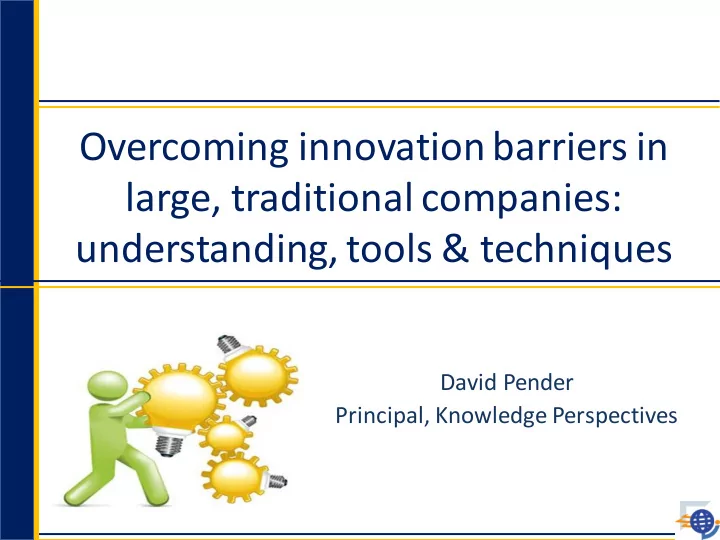

Overcoming innovation barriers in large, traditional companies: understanding, tools & techniques David Pender Principal, Knowledge Perspectives
“The innovation gene is missing from our DNA” President, Large Singaporean Engineering Company (4000+ employees)
Today • The “off” switch • The “on” switch • Potential consulting approaches • A model
The “off” switch • No agenda • No senior executive responsibility • Budget (other than R&D) Organisation • Lack of a platform • Fixed mindset • Need for control, strong hierarchies • Myopia Culture • Strong internal focus • Innovation skills • Mistaken belief that you need “creatives” • Headspace People
But it is not all bad news ….
The collaboration-creativity nexus The Collaboration/Creativity Connection Culture & Culture & Alignment Facilitation Skills Outlets Climate Climate Tools Networks WIIFM Facilitation Collaboration Creativity Innovation Finance Process Offerings Delivery New Revenue Business Networks Enabling Core Product Product Service Channel Brand Customer Reduced Costs Streams performance models & alliances processes processes systems experienc e The way we The way we What supports Directly create Design & Platform for Beyond and Getting our Identify & How our make money join forces core processes and add value functionality multiple around our offering to communicate customers feel & employees to our products products market our offering offerings
The “on” switch (fundamentals) Budget Culture Responsibilities Skills External focus Platform
Responsibilities
Innovation network (role)
Innovation network (SM)
Innovation network (between SM)
Innovation network (between MM)
Budget
Culture
Culture - Singapore Large Company Clan 40 35 30 25 20 15 10 5 Hierarchy Adhocracy 0 Market
Sense making Mental Plausible Identity models stories Uncertainty Unintelligible Sense Environmental making changes Cognitive Chaos gap driver Complexity Future Situational actions awareness
Skills
Skills Personal Innovation Enablers Organisational Self leadership Idea curation learning Creativity Decision making Engagement Communication Problem solving Headspace Project Trust, respect Recognition etc management Systems thinking Platform Networks “Ba” Working x- disciplines
External focus
Platform
A maturity model for innovation •Prevailing conditions do not Unaware promote innovation. Little awareness exists. •Aware of conditions impacting Conscious innovation and starting to address them. •Enabling conditions are somewhat Functional patchy but momentum is being gained. •Conditions which support innovation Promising are usually effective. Benefits are being realised. •Conditions optimally Leading support innovation. •Strong benefits realised
A platform Leadership Environment People Connectedness Resources Approach Alignment of Resource Strategic clarity Trust & respect Transparency Internal process skills sufficiency Staff Innovation engagement & Diversity Connectivity Headspace Path to impact Leadership empowerment Multi- Innovation skill Infrastructure & Recognition & Risk taking disciplinary development technology reward partnerships Customer/ Organisational vendor Governance learning engagement Physical workspace
So, who needs to do what? Employees Middle Managers Executive
Potential consulting approaches Appreciative Culture Networks Inquiry Knowledge Leadership Strategy management and many more …
OR, a X- disciplinary approach
The KP3 model
How do we build a sandbox?
Contacts David Pender Principal, Knowledge Perspectives +61 408804490 david@kp3.com.au In Singapore Chan Veng Seng +65 98253489 veng.seng@gmail.com
A KM APPROACH
KM routines for innovation Prepared for I Mobilise tacit and • • explicit K – Pick up signals Enable & manage the – Process that • information K creation & deployment processes Managers share an • understanding of D-R-N process • – Innovation processes – Creation of structures etc Strategic portfolio of I • projects
Process model KM for innovation Discovery Realisation Nurture Phases Search Contextualise Evaluate Routines Capture Apply Support Articulate Re-innovate
Phase: Discovery Generic routine Description Search The passive & active means by which potential knowledge sources are scanned for items of interest Capture The means by which knowledge search outcomes are internalised within the organisation Articulate The means by which captured knowledge is given clear expression
Phase: Realisation Generic routine Description Contextualise The means by which articulated knowledge is placed in particular organisational contexts Apply The means by which contextualised knowledge is applied to organisational challenges
Phase: Nurture Generic routine Description Evaluate The means by which the efficacy of knowledge applications is assessed Support The means by which knowledge applications are sustained over time Re-innovate The means by which knowledge and experience are re-applied elsewhere within the organisation
Organisational learning (Huber 1991) Congenital Knowledge Individual Intuiting learning acquisition Interpreting Experiential Information learning distribution Organisational learning Group Integrating Vicarious Information learning interpretation Institutionalising Organisational Organisation Grafting memory Searching & noticing
Recommend
More recommend